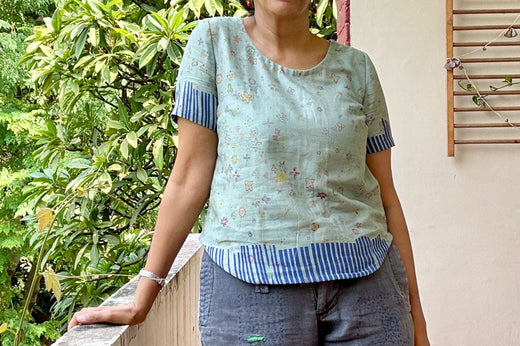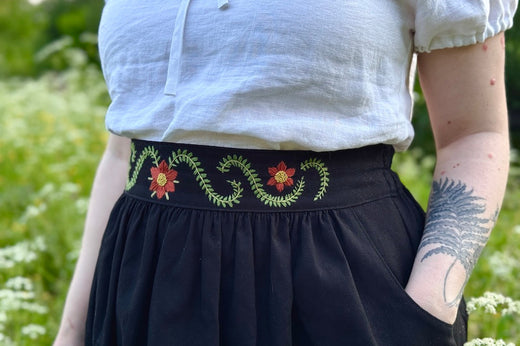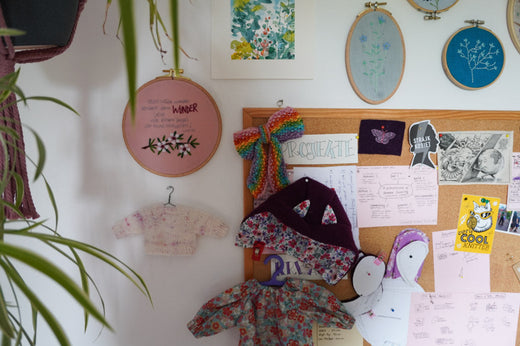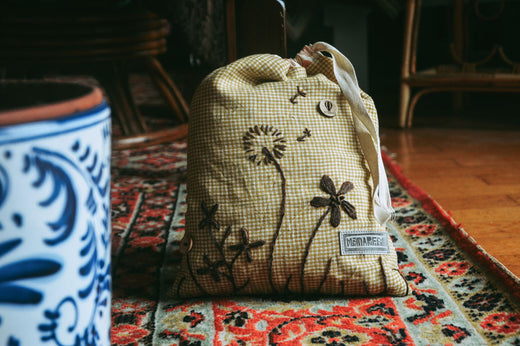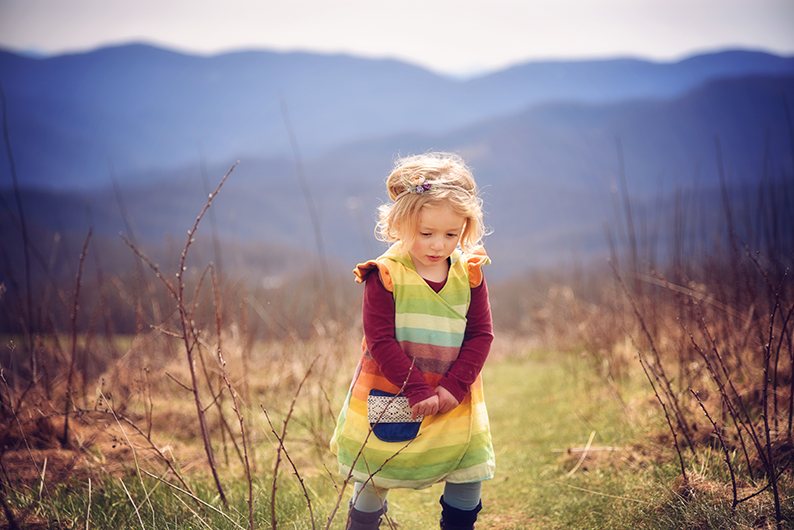We are so pleased to welcome Marie Jelenka Kirchner to the Twig + Tale blog, sharing her reflections on our monthly theme, 'Document'. Providing us with a peek into her creative journalling practice, Marie explains how she plans and records her sewing projects, and uses journalling as an important part of her intentional 'Me Made' sewing journey.

Writing, journalling and documenting have always been a big part of my life. Diaries helped me from a young age to structure my thoughts and reflect on the events of the days. I am a person of many notebooks, carefully archived paperback diaries and hand-written lists in floral framing.
Putting things down on paper is a welcome way for me to slow down, to reflect, to structure my day and my projects - especially when all seems just too overwhelming - and to “file” any inspiration that might otherwise get lost in the turbulent stream of the day. Sitting down with my knitting, my notebooks and a pot of tea is an elementary part of my daily morning routine.

How does all of this relate to my sewing?
Documentation and journalling are central aspects of my crafting process. Conscious and intentional crafting can be hard to integrate into an often hectic life with just so much going on.
I want my creative projects to be a resource for me - to bring me joy, to wind down, to provide energy - rather than to drain what little spirits I might have left in the evening.
All of the tools I use make my life easier, help my imagination flow and create head space for other things. As soon as any of the note-taking, list-keeping or photo-snapping feels like a chore it might not be the right tool for you, and that’s okay.

What do I really want? Putting creative intentions down
The Fashion Revolution Movement, i.e. the desire to be more sustainable and more ethical in my garment consumption, sparked my Me Made Journey. But, with the right amount of money and time, it is easy to quickly fall into a spiral of shopping just as much as before - only in supplies, not mass-produced garments.
I am careful to speak of “me made fast fashion”, because fast fashion is the whole big system of exploitation, nature destruction, in-transparency and overconsumption. Nonetheless, I still believe that we should be aware of our individual impact, and amount of production, too.
Sewing is a quick craft, overall. I was a knitter before I became a sewist, and those two crafts work in different dimensions of speed. I quickly realised patterns of “impulsive sewing” that I just didn’t know from knitting.
Putting my creative intentions down on paper has helped me slow down my sewing process from idea to finished product. It helps me to collect inspiration before I rush into the fabric store. I sit down and ask myself:
What clothes do I really need in my life? What colours do I love? What works with what I already have, and what doesn’t, and why?

Above: a picture of my pinboard, installed above my desk. This is where I structure my ideas, want-to-make lists, my colour concept or creative intentions (next to work and PhD related notes in a similar design).
Creating only the best styles (for me): My own Look-book
Do you sometimes make something, only to realise that it doesn’t really work with your life, your taste or what’s already in your closet? I know that feeling all too well - and that’s why I keep track of my ideas with what I call “my look-book”.

I originally started this collection of fashion sketches when I first started sewing to make sure my sewing matched my knitting, and to avoid rushed production. Today, I use it to put down outfit ideas, collect colour and/or pattern options and play around with ideas that might also include garments I already own. Some people prefer to collect this kind of inspiration through Pinterest boards, but the idea is similar.

Some looks grow on me, and they become reality. Others are nice to look at, but I realise that they aren’t really my style.
I found my look-book to be a great resource to slow down in my making, and also to help me get my creative spirits back in uninspired times. If you dread drawing figures yourself, you could print paper mannequins and play dress-up with them. I like to return to the same look again and again and add elements here and there.

If I have settled on a pattern that I wish to make, I’ve found the creation of “collections” quite useful for me. That way I ensure that the garments I make over the course of a few weeks or months work together for the same purpose (like “spring exploring”, or “camping trip”).
In the past, I have ruled out some garments that I liked individually, but realised they would only really work with a pair of jeans (an immediate disqualify for me). Collections are also a great way for me to put down different options for the same fabric (if I'm very undecided), scrap projects or "gift sewing ideas".

If your creative time is precious and rare, lots of drawing might keep you from the sewing table - that isn’t the idea! But if you are unsure what exactly you want to make; or your challenge is more one of “too much” than “too little”; or you tend to always come home with colours or patterns you just don’t love, this kind of creative reflection might be perfect!

Getting the most out of the making: Documenting the process
For me, as I am sure for many other makers, my creative endeavours are a constant learning process.
Where did I struggle when making a pattern, and what did I do? What new trick did I learn? How did I like the instructions and why? Did I have to alter the size much (how did I do it?!).
For the first year or so I told myself that I would just remember these things (I didn’t). Next up, I started a little notebook with blank pages where I would irregularly scribble some comments on this or that project. It helped, but it wasn’t ideal.
A few months ago, I created some bullet-journalling pages to fill out for each and every project I create, and it’s worked wonders for me! Reflecting on my project has become a part of my sewing that I look forward to. My own design has helped me enter just what I deem necessary. And the cute illustration has me come back for reference with joy!
As I sew, I have become more attentive to the challenges I encounter: what went wrong, and why? What could I do better? What should I definitely remember next time? It has added a new layer of consciousness to my sewing that I love.

Above: I found the spreadsheet particularly useful to put pattern hacks down, like I did with this cropped Driftwood Blouse (Button Add-On)
I am sure that these kind of process trackers exist somewhere on the internet - or you could do it like myself: create your own sample with the information that you find relevant and then run it a couple of times through the copy machine. The trick for a neat-looking page is the use of boxes and framings.
I include space for expenses on my page. This is an important aspect of transparent documentation for me (and one that I think isn’t talked enough about in creative circles). I am also interested in the longevity of a piece or material which is why I like to return after a while to describe how the fabric holds up.

Going down #memade memory lane, over and over again.
Are you a nostalgic person? I certainly am. I like to explore long-grown traditions, learn about (and from) the past and travel down (my own) memory lane, over and over again.
My family has always preserved memory with photos and I just love my maternal family photo archive from the 20th century, including all the hand-tailored garments by my great grandmother and, more importantly, documentation of her political resistance and work!
During those long pandemic years, my partner and I enjoyed looking for nice spots nearby to both create beautiful memories in a dreadful time, and photograph my me-mades. Documenting our mini adventures in me-mades has become a fun couple activity and I do also enjoy the community that I have found online by sharing my makes on social media, like the Twig & Tale Storyteller team.

Above: From vision to reality - a Fernway Culotte Look for a special occasion
Do you know the tale of Frederick the Mouse (by Leo Lionni) who collects colour, sun rays and stories during summer to share with his mouse friends in long and cold winter? Especially with the pandemic still here, I am making a conscious effort to experience, and photograph, summer adventures this year for a long, and potentially isolated, winter ahead.

Above: A visit to the Styrian Apple Blossom Festival earlier this year was one of those precious spring adventures, dressed in style with my bunny-embroidered Fable Dress and my partner’s Breeze Shirt
Visualization is key - for me. And maybe for you?
Visualisation, hand lettering and bullet journalling are on trend. Pretty scribbles are often marketed as self-care, and there’s quite a bit of pressure for everything to be extra pretty and Instagrammable. But visual documentation of your thoughts and ideas only works in your favour if you can find support in it, rather than yet another dreadful to-do.
For me journalling and documentation isn’t about perfection. It is about reflection, consciousness and a deep nourishing of my own wants and needs.

Marie Jelenka Kirchner has been knitting and sewing enthusiastically for a few years. Her MeMade journey was sparked by her love for vintage-style knitwear, paired with a conscious effort to avoid fast fashion. Marie is a researcher on European Union affairs and pursues a PhD in political science at Graz University. She shares insights into her (feminist) thoughts and crafting HERE.
There is lots more great Storyteller content on the T+T blog! Click here to view all of the Storyteller articles.

